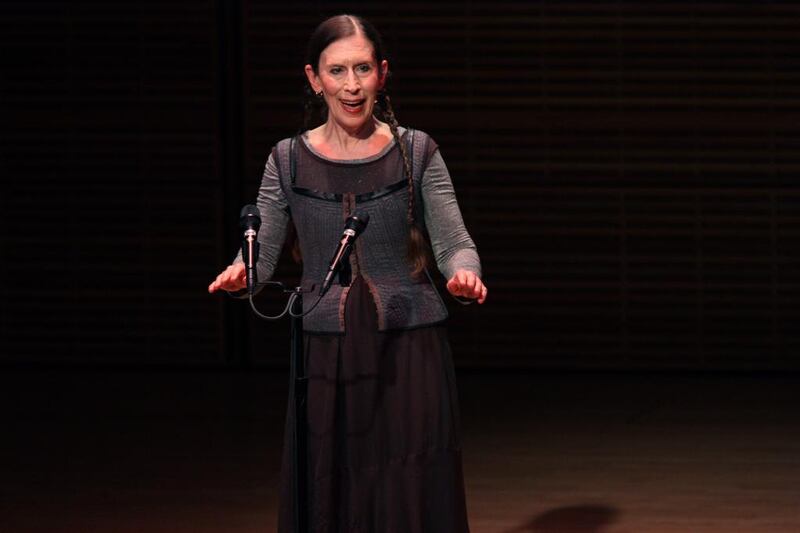Meredith Monk can remember well the day she read her own obituary.
Touring Japan in 1982, the American musician spotted the tribute in a national newspaper. It was written by experimental Japanese musician Ryuichi Sakamoto, one of Monk’s “super-favourite composers”. Jazz great Thelonious Monk had just died, and it seems the editors got confused.
“It was shocking,” says Monk who is now 73. “I never kept it. I guess I thought it was a bad omen – but in a way, I guess I wish I had.”
The story is both funny and tragic – but also serves to highlight the core pleasures, and perhaps barriers, in Monk’s music – no one knows quite how to categorise it. She recalls earlier in the same trip spotting her records in a rack alongside her namesake’s.
Monk is hardly a jazz artist, but even record shop nerds are at a loss where to file her work (when pushed, she begrudgingly concedes to the Contemporary Classical bracket, but prefers the term New Music).
For more than 50 years, she has been making art that transcends conventional definition, an interdisciplinary approach combining music and voice with choreographed movement and symbols. While the sonic aspect has been bottled on a string of album releases, most notably for ECM, a Meredith Monk performance is about more than music – it is a collage of image, object, light and sound.
In September last year, US president Barack Obama awarded Monk the National Medal of Arts in recognition of her five-decade career, which will be celebrated during an anniversary retrospective performed over three concerts at New York University Abu Dhabi next week. The show was conceived during an artistic residency at New York’s Carnegie Hall last year.
The centrepiece was a four-hour, all-star concert to show how far Monk’s influence has spread. Guests included Sonic Youth guitarist Lee Ranaldo, hip-hop DJ Spooky, and avant-garde composer John Zorn.
Monk’s later career has heralded a move into instrumental composition, but at the heart of her most distinctive work – from the early solo recordings to the experimental Vocal Ensemble she founded in 1978 and still leads today – is Monk’s own voice.
A beguiling freak-of-nature howl, it conjures primordial sounds as if from another planet. Monk is known for employing “extended vocal techniques” that push beyond traditional singing methods, making sounds not words, and heard once, her voice is unmistakable.
The way she tells it, Monk’s path was set the day, in the mid-1960s, when she realised “the voice could have the same flexibility and range of movement as a spine or a foot”.
Where, then, might Monk be if she had not been born with this three-octave weapon?
“That’s an amazing question,” says Monk. “Right from the beginning I realised that would be the anchor and core of the work emotionally. I can’t imagine doing anything without it.
“The voice has such a profound connection to the emotions for which we don’t have words – it’s a way of uncovering those fundamental human energies.”
When talking and writing about Monk’s music, listeners scrabble to unravel layers of influence, pointing to everything from medieval plainchant to 20th-century minimalism – something both compellingly visionary and innately ancient. Astute observers point to Monk’s background as a 1960s coffeehouse folksinger.
“I work from the inside-out,” says Monk.
“I think the honesty, directness and poignancy of folk music is something that I always loved and wanted to have in my work. Then the freedom of jazz and strength of classical music, and the visceral quality of rock n’ roll – all of those things are part of our musical heritage, our environment.”
The musician Monk is most often associated with, quite misleadingly, is Björk. The Icelandic iconoclast is a lifelong fan who covered Monk's Gotham Lullaby. After years of "postcard contact", the pair finally met in 2005 for a joint interview for America's National Public Radio. By the end, both women were in tears. Work began on a duet which might not "ever be done".
“I don’t feel like her work is so much like mine, but she has a spirit which is very related to mine,” says Monk.
“In a way, I feel like I’m mum, artistic mum – we have a very sweet friendship.”
Much of Monk’s music is “untranscribable” – she teaches collaborators with tapes and demonstrations – however, as Monk reaches the middle of her eighth decade, work is underway to notate select pieces.
The legacy is being preserved, even if it requires as many as five different notation systems, maps and charts to document a single piece.
“I felt that I wanted other people to have the joy of performing this work,” she says. “I hope people do, I really do. I’ve devoted my life to this, from the time I was 20 – I hope it will outlast me.”
• Meredith Monk & Vocal Ensemble perform at Black Box, The Arts Center, NYUAD, Saadiyat Island, on Sunday and Monday at 8pm, and on Tuesday at 10am. Register for free tickets from nyuad-artscenter.org
rgarratt@thenational.ae










